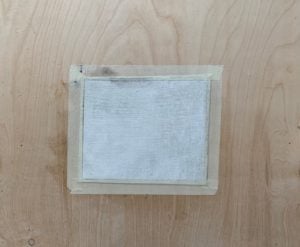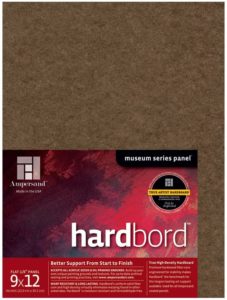Wood art panels for painting are supports which create a surface that you can lay your painting down on. There are quite a few different painting supports but in this article we are focused on exploring wood art panels for support!
Wood is one of the most common painting supports that painters use and is what was used for the painting above by Jan Van Eyck. There are a few different ways wood boards can be used for paintings – all of which we will go over here. One can either mount a painting with glue onto a wooden panel support. Or use wood art panels to temporarily attach a gessoed piece of canvas, for support during the process of the painting.
Why Are Wood Art Panels Good Supports for Paintings?
The main advantage of using a rigid surface like wood is that it exerts no strain into the paint layers. By that I mean that the painting is less likely to crack or become bent in some way. In addition, during the process of painting a rigid surface is excellent for being able to apply any pressure onto the surface without worrying about damaging the surface.
Natural Wood Art Panels
The main defect of a wood support is its tendency to sometimes warp, shrink or expand. The two wood types are:
Softwood:
Often have a lot of resin and sometimes deteriorate quickly.
Hardwoods:
This variety is more durable and resistant to wet rot.
Purchasing Wood Boards from a Lumber Store
Purchasing Ready Made Boards
I am a fan of purchasing ready made boards as I personally do not have the equipment to cut my own wood art panels. There are some excellent archival quality boards available on the market today. The only down side is that you are limited to standard sizes boards. If you want to have a custom sized board you will either need to find a way to use wood cutting machines or contact a wood worker.
Different Ways to Use Wood Art Panels for a Painting
Mounting Canvas onto the Wood Art Panel:
Paint Directly on the Wooden art panel:
You can paint directly onto a wood panel that has been applied with gesso or treated with rabbit skin glue.
Using a Wood Board as a Temporary Support:

Ready Made Wood Art Panels
Wood Art Panels Actually Last a Long Time
Jan Van Eyck used an oak panel for one of his works. It is coated on the back with gesso glue and tow. Additionally, it is covered in black varnish. To this day it is free from woodworm and is in perfect condition.
Manmade wood
Examples of Other Rigid Supports:
- Aluminum
- Fiberglass
- Steel
- Copper
Recommended Wood Art Panels Available
Here are some wood panels that I recommend and use myself. They are all ready made and are in standard sizes.
Raw Wood Birch Panel
This is a simple raw wood panel that can be used in a variety of ways – either to mount canvas on or paint directly on after treated with gesso or rabbit skin glue.
Ampersand Hardboard Panel
These are one of my very favorite hardboard panels! You can find them in either cradled versions or 1/8 inch thick panels.
Cradled Wood Panels
Cradled panels can be great if you are looking to have more support on your painting surface. Having a cradled panel can save your painting from getting warped! There are typically different thicknesses offered – 7/8 in, 1 1/2 in, or 2 1/2 inch.
Richeson Hardboard Panels
I love these painting panels! They are a great affordable option that I often use for my own work. I also sometimes use the larger sizes as a support to temporarily mount a painting too as I work on it.









6 thoughts on “Wood Art Panels For Painting – Complete Guide For Artists”
You say don’t use hardboard but also recommend two kinds of hardboard panels – Ampersand and Richeson. What is different about them please?
Hi Lynne, I say the opposite in the article – I recommend hardboard panels 🙂 And I especially recommend Ampersand and Richeson panels. Richeson tends to be less expensive but Ampersand hardboards are more rigid and durable.
How many coats of gesso do u use on birch wood panel?
Hi Patrick, 3 – 4 coats of gesso should be adequate for a birch wood panel for oil painting. If you are gessoing it for acrylic paints then 2 coats should be enough.
Thanks Elizabeth. Love your very informative articles
You are so welcome Mary – very glad that you enjoy the articles 🙂